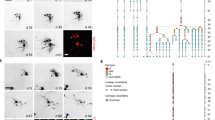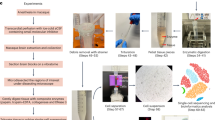Abstract
Neurogenesis persists in the adult mammalian hippocampus. To identify and isolate neuronal progenitor cells of the adult human hippocampus, we transfected ventricular zone-free dissociates of surgically-excised dentate gyrus with DNA encoding humanized green fluorescent protein (hGFP), placed under the control of either the nestin enhancer (E/nestin) or the Tα1 tubulin promoter (P/Tα1), two regulatory regions that direct transcription in neural progenitor cells. The resultant P/Tα1:hGFP+ and E/nestin:enhanced (E)GFP+ cells expressed βIII-tubulin or microtubule-associated protein-2; many incorporated bromodeoxyuridine, indicating their genesis in vitro. Using fluorescence-activated cell sorting, the E/nestin:EGFP+ and P/Tα1:hGFP+ cells were isolated to near purity, and matured antigenically and physiologically as neurons. Thus, the adult human hippocampus contains mitotically competent neuronal progenitors that can be selectively extracted. The isolation of these cells may provide a cellular substrate for re-populating the damaged or degenerated adult hippocampus.
This is a preview of subscription content, access via your institution
Access options
Subscribe to this journal
Receive 12 print issues and online access
$209.00 per year
only $17.42 per issue
Buy this article
- Purchase on Springer Link
- Instant access to full article PDF
Prices may be subject to local taxes which are calculated during checkout







Similar content being viewed by others
References
Altman, J. & Das, G.D. Autoradiograpbhic and histological evidence of postnatal hippocampal neurogenesis in rats. J. Comp. Neurol. 124, 319–335 ( 1965).
Kaplan, M.S. & Hinds, J.W. Neurogenesis in the adult rat: electron microscopic analysis of light radioautographs. Science 197, 1092–1094 (1977).
Bayer, S., Yackel, J. & Puri, P. Neurons in the rat dentate gyrus granular layer substantially increase during juvenile and adult life. Science 216 , 890–892 (1982).
Barnea, A. & Nottebohm, F. Seasonal recruitment of hippocampal neurons in adult free-ranging black-capped chickadees. Proc. Natl. Acad. Sci. USA 91, 11217–11221 (1994).
Gould, E., McEwen, B., Tanapat, P., Galea, L. & Fuchs, E. Neurogenesis in the dentate gyrus of the adult tree shrew is regulated by psychosocial stress and NMDA receptor activation. J. Neurosci. 17, 2492–2498 (1997).
Gould, E., Tanapat, P., McEwen, B., Flugge, G. & Fuchs, E. Proliferation of granule cell precursors in the dentate gyrus of adult monkeys is diminished by stress. Proc. Natl. Acad. Sci. USA 95, 3168–3171 ( 1998).
Eriksson, P. et al. Neurogenesis in the adult human hippocampus. Nature Med. 4, 1313–1317 ( 1998).
Gould, E., Cameron, H., Daniels, D., Wooley, C. & McEwen, B. Adrenal hormones suppress cell division in the adult rat dentate gyrus. J. Neurosci. 12, 3642 –3650 (1992).
Kempermann, G., Kuhn, H. & Gage, F. More hippocampal neurons in adult mice living in an enriched environment. Nature 386, 493–495 ( 1997).
van Praag, H., Kempermann, G. & Gage, F. Running increases cell proliferation and neurogenesis in the adult mouse dentate gyrus. Nature Neurosci. 2, 266–270 (1999).
Gould, E., Beylin, A., Tanapat, P., Reeves, A. & Shors, T. Learning enhances adult neurogenesis in the adult hippocampal formation. Nature Neurosci. 2, 260– 265 (1999).
Kornack, D. & Rakic, P. Continuation of neurogenesis in the hippocampus of the adult macaque monkey. Proc. Natl. Acad. Sci. USA 96, 5768–5773 ( 1999).
Palmer, T., Takahashi, J. & Gage, F. The adult rat hippocampus contains primordial neural stem cells. Molec. Cell Neurosci. 8, 389 –404 (1997).
Kukekov, V. et al. Multipotent stem/progenitor cells with similar properties arise from two neurogenic regions of adult human brain. Exp. Neurol. 156, 333–344 ( 1999).
Suhonen, J., Peterson, D., Ray, J. & Gage, F. Differentiation of adult hippocampus-derived progenitors into olfactory neurons in vivo. Nature 383, 624–627 (1996).
Miller, F., Naus, C., Durand, M., Bloom, F. & Milner, R. Isotypes of α-tubulin are differentially regulated during neuronal maturation. J. Cell Biol. 105, 3065–3073 (1987).
Gloster, A. et al. The Tα1 α-tubulin promoter specifies gene expression as a function of neuronal growth and regeneration in transgenic mice. J. Neurosci. 14, 7319–7330 (1994).
Wang, S. et al. Identification and enrichment of forebrain neuronal precursor cells by fluorescence-activated sorting of ventricular zone cells transfected with GFP regulated by the Tα1 tubulin promoter. Nature Biotechnol. 16, 196–201 ( 1998).
Frederiksen, K. & McKay, R.D. Proliferation and differentiation of rat neuroepithelial precursor cells in vivo. J. Neurosci. 8, 1144–1151 (1988).
Zimmerman, L. et al. Independent regulatory elements in the nestin gene direct transgene expression to neural stem cells and muscle precursors. Neuron 12, 11–24 ( 1994).
Pincus, D.W. et al. FGF2/BDNF-associated maturation of new neurons generated from adult human subependymal cells. Ann. Neurol. 43, 576–585 (1998).
Lee, M., Rebhun, L. & Frankfurter, A. Posttranslational modification of class III β-tubulin . Proc. Natl. Acad. Sci. USA 87, 7195– 7199 (1990).
Menezes, J.R. & Luskin, M.B. Expression of neuron-specific tubulin defines a novel population in the proliferative layers of the developing telencephalon . J. Neurosci. 14, 5399– 5416 (1994).
Bernhardt, R. & Matus, A. Light and electron microscopic studies of the distribution of microtubule-associated protein 2 in rat brain: a difference between dendritic and axonal cytoskeletons. J. Comp. Neurol. 226, 203–221 (1984).
Chalfie, M., Tu, Y., Euskirchen, G., Ward, W. & Prasher, D. Green fluorescent protein as a marker for gene expression . Science 263, 802–805 (1994).
Wang, S., Roy, N., Benraiss, A., Harrison-Restelli, C. & Goldman, S. Promoter-based isolation and purification of mitotic neuronal progenitor cells from the adult mammalian ventricular zone. Dev. Neurosci. 22, 167–176 (2000).
Lothian, C. & Lendahl, U. An evolutionarily conserved region in the second intron of the human nestin gene directs gene expression to CNS progenitor cells and to early neural crest cells. Eur. J. Neurosci. 9, 452–462 ( 1997).
Rossant, J., Zirngibl, R., Cado, D., Shago, M. & Giguere, V. Expression of a retinoic acid response element-hsp/lacZ transgene defines specific domains of transcriptional activity during mouse embryogenesis. Genes Dev. 5, 1333– 1344 (1991).
Roy, N. et al. Promoter-targeted selection and isolation of neural progenitor cells from the adult human ventricular zone. J. Neurosci. Research 59, 321–331 ( 2000).
Kirschenbaum, B. et al. In vitro neuronal production and differentiation by precursor cells derived from the adult human forebrain. Cerebral Cortex 4, 576–589 ( 1994).
Sontheimer, H., Mintuen, J.E., Black, J.A., Ransom, B. & Waxman, S. Two types of Na(+)-currents in cultured rat optic nerve astrocytes: changes with time in culture and with age of culture derivation. J. Neurosci. Res. 30, 275– 287 (1991).
Sontheimer, H., Black, J.A., Ransom, B.R. & Waxman, S. Ion channels in spinal cord astrocytes in vitro. I. Transient expression of high levels of Na+ and K+ channels. J. Neurophysiol. 68, 985–1000 (1992).
Tse, F.W., Fraser, D.D., Duffy, S. & MacVicar, B.A. Voltage-activated K+ currents in acutely isolated hippocampal astrocytes. J. Neurosci. 12, 1781–1788 ( 1992).
Kang, J., Jiang, L., Goldman, S. & Nedergaard, M. Astrocyte-mediated potentiation of inhibitory synaptic transmission. Nature Neurosci. 1, 683–692 ( 1998).
Lendahl, U., Zimmerman, L.B. & McKay, R.D. CNS stem cells express a new class of intermediate filament protein. Cell 60, 585– 595 (1990).
McKay, R. Stem cells in the central nervous system. Science 276 , 66–71 (1997).
Roy, N. et al. Identification, isolation and enrichment of oligodendrocyte progenitor cells from the adult human subcortical white matter. J. Neurosci. 19, 9986–9995 ( 1999).
Doetsch, F., Caille, I., Lim, D., Garcia-Verdugo, J. & Alvarez-Buylla, A. Subventricular zone astrocytes are neural stem cells in the adult mammalian brain. Cell 97, 703–716 (1999).
Barami, K., Iversen, K., Furneaux, H. & Goldman, S.A. Hu protein as an early marker of neuronal phenotypic differentiation by subependymal zone cells of the adult songbird forebrain. J. Neurobiol. 28, 82–101 (1995).
Levy, J., Muldoon, R., Zolotukhin, S. & Link, C. Retroviral transfer and expression of a humanized, red-shifted green flourescent protein gene into human tumor cells. Nature Biotechnol. 14, 610–614 (1996).
Acknowledgements
We thank H.M. Keyoung for comments on the manuscript. This work was supported by the National Multiple Sclerosis Society, the Aitken Charitable Trust, the G. Harold and Leila Y. Mathers Charitable Foundation, the Human Frontiers Scientific Program, and National Institute of Neurological Disorders and Stroke grants R01NS29813 and R01NS33106.
Author information
Authors and Affiliations
Corresponding author
Rights and permissions
About this article
Cite this article
Roy, N., Wang, S., Jiang, L. et al. In vitro neurogenesis by progenitor cells isolated from the adult human hippocampus. Nat Med 6, 271–277 (2000). https://doi.org/10.1038/73119
Received:
Accepted:
Issue Date:
DOI: https://doi.org/10.1038/73119
This article is cited by
-
EGFL7 loss correlates with increased VEGF-D expression, upregulating hippocampal adult neurogenesis and improving spatial learning and memory
Cellular and Molecular Life Sciences (2023)
-
Adult human neurogenesis: early studies clarify recent controversies and go further
Metabolic Brain Disease (2022)
-
Exercise ameliorates aberrant synaptic plasticity without enhancing adult-born cell survival in the hippocampus of serotonin transporter knockout mice
Brain Structure and Function (2021)
-
Recent progress in the research of suicide gene therapy for malignant glioma
Neurosurgical Review (2021)
-
ATP and spontaneous calcium oscillations control neural stem cell fate determination in Huntington’s disease: a novel approach for cell clock research
Molecular Psychiatry (2021)



